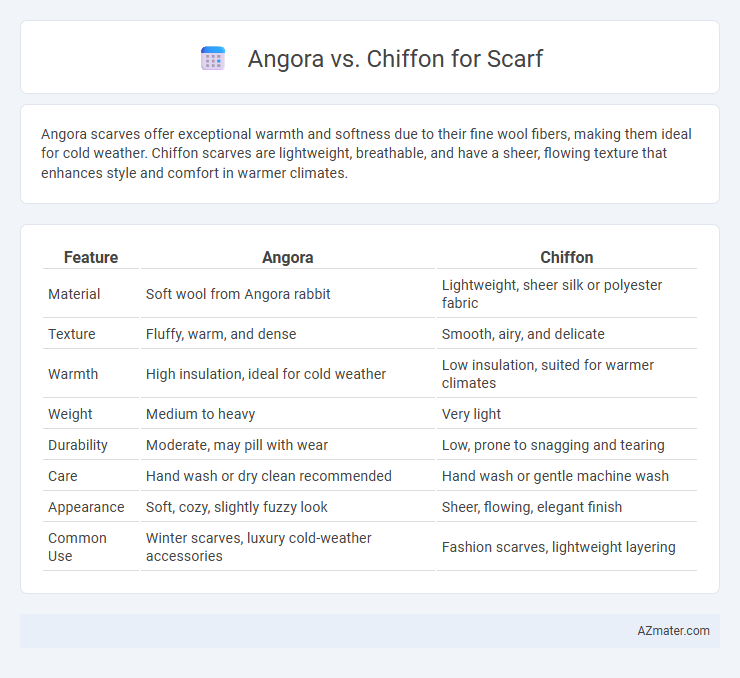Angora scarves offer exceptional warmth and softness due to their fine wool fibers, making them ideal for cold weather. Chiffon scarves are lightweight, breathable, and have a sheer, flowing texture that enhances style and comfort in warmer climates.
Table of Comparison
| Feature | Angora | Chiffon |
|---|---|---|
| Material | Soft wool from Angora rabbit | Lightweight, sheer silk or polyester fabric |
| Texture | Fluffy, warm, and dense | Smooth, airy, and delicate |
| Warmth | High insulation, ideal for cold weather | Low insulation, suited for warmer climates |
| Weight | Medium to heavy | Very light |
| Durability | Moderate, may pill with wear | Low, prone to snagging and tearing |
| Care | Hand wash or dry clean recommended | Hand wash or gentle machine wash |
| Appearance | Soft, cozy, slightly fuzzy look | Sheer, flowing, elegant finish |
| Common Use | Winter scarves, luxury cold-weather accessories | Fashion scarves, lightweight layering |
Understanding Angora and Chiffon Fabrics
Angora fabric, derived from the Angora rabbit, is prized for its exceptional softness, lightweight warmth, and natural elasticity, making it ideal for luxurious scarves that provide comfort and insulation. Chiffon, a sheer, lightweight fabric made from silk, nylon, or polyester, offers a delicate, flowing texture and breathability, perfect for stylish, breathable scarves suited for mild weather. Understanding these materials helps in selecting scarves that balance warmth and elegance, with Angora excelling in insulation and Chiffon in lightweight sophistication.
Texture and Feel: Angora vs Chiffon
Angora scarves offer a luxuriously soft and fluffy texture derived from Angora rabbit fibers, providing exceptional warmth and a cozy feel against the skin. Chiffon scarves are lightweight and sheer, featuring a smooth, slightly crisp texture that drapes elegantly but lacks insulating properties. While Angora excels in softness and thermal comfort, chiffon is preferred for its delicate, airy feel and flowing movement.
Warmth and Breathability Comparison
Angora scarves provide exceptional warmth due to their dense, fine fibers that trap heat effectively, making them ideal for cold climates. Chiffon scarves, made from lightweight and sheer fabric, offer superior breathability, allowing air to flow freely and preventing overheating. Choosing between Angora and Chiffon depends on the need for insulation versus ventilation in scarf wear.
Durability and Longevity of Each Fabric
Angora scarves are known for their soft texture but require delicate care due to the fine fibers that can shed and weaken with frequent washing, impacting durability. Chiffon scarves, made from tightly woven synthetic or silk fibers, offer greater resistance to wear and maintain their structure longer under regular use. While Angora provides warmth and softness, chiffon's durability and longevity make it ideal for daily accessories needing long-term resilience.
Style and Aesthetic Differences
Angora scarves offer a luxurious, soft texture with a plush, voluminous appearance that exudes warmth and elegance, ideal for sophisticated winter looks. Chiffon scarves provide a lightweight, sheer fabric with a delicate, flowing drape that enhances outfits with a graceful and airy aesthetic, perfect for spring and summer styles. The contrast between Angora's rich bulkiness and Chiffon's ethereal translucence highlights distinct style preferences for seasonal and formal wear.
Care and Maintenance Requirements
Angora scarves require delicate hand washing with cold water and mild detergent to maintain their softness and prevent fiber damage, while chiffon scarves are easier to care for, often machine washable on a gentle cycle. Both fabrics benefit from air drying flat to preserve shape and avoid stretching, but angora's natural fibers demand more cautious handling to avoid pilling and matting. Proper storage in a breathable fabric bag protects angora's delicate texture, whereas chiffon scarves can be stored more flexibly due to their synthetic or silk composition.
Ideal Occasions for Angora Scarves
Angora scarves are ideal for cold winter days, offering exceptional warmth and softness due to their fine, insulating fibers derived from Angora rabbits. They are perfect for formal events or outdoor activities in chilly weather, where comfort and elegance are essential. Chiffon scarves, by contrast, suit warmer seasons and casual occasions, emphasizing lightness and breathability over insulation.
Best Settings for Chiffon Scarves
Chiffon scarves require delicate handling with low heat settings on irons or steamers to prevent fabric damage and maintain their sheer, lightweight texture. Using a pressing cloth and avoiding direct contact with heat sources ensures the chiffon retains its smoothness and vibrant colors. Angora scarves, by contrast, benefit from gentle hand washing and air drying to preserve their softness and minimize pilling.
Price and Accessibility Overview
Angora scarves typically command higher prices due to the luxury and softness of angora wool, which comes from angora rabbits and requires a labor-intensive harvesting process. Chiffon scarves are generally more affordable and widely accessible, made from polyester or silk blends that are mass-produced and readily available in various retail outlets. Consumers seeking exclusive warmth and softness often invest more in angora, whereas those prioritizing budget and variety find chiffon scarves easier to acquire.
Which Scarf Fabric is Right for You?
Angora scarves offer exceptional warmth and softness due to their fine, natural fibers, making them ideal for cold weather and sensitive skin. Chiffon scarves are lightweight, breathable, and versatile, perfect for stylish layering and warmer climates. Choosing between Angora and Chiffon depends on your need for insulation versus elegance and comfort in mild temperatures.

Infographic: Angora vs Chiffon for Scarf
 azmater.com
azmater.com